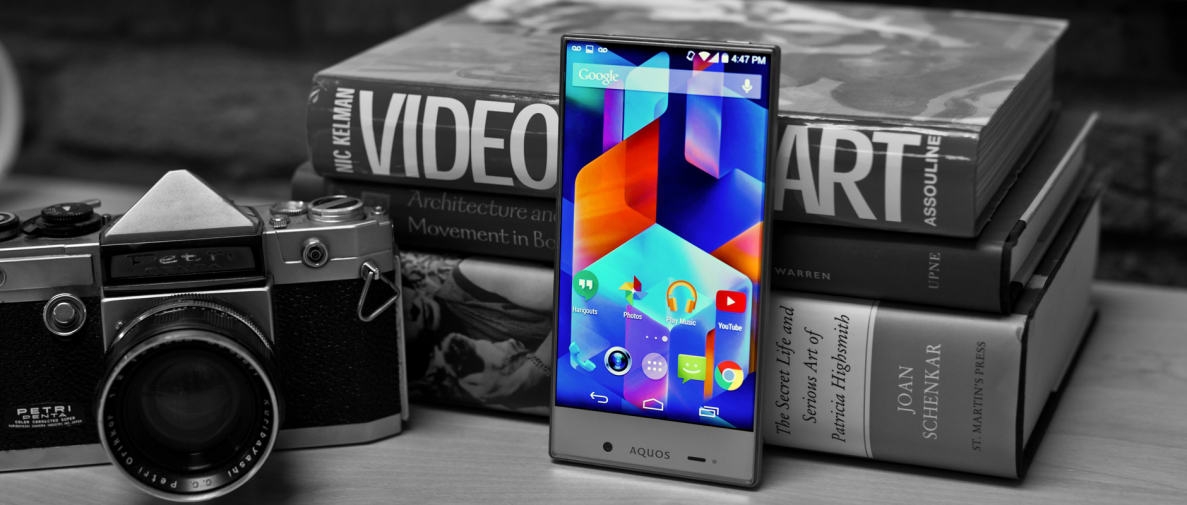Unfortunately, most can't afford to shell out for a top-tier handset at a moment's notice. It's no surprise, then, that budget carrier-unlocked phones have seen a renaissance. No longer do you need to wait for an upgrade to get a new phone, and no longer do you need to pay a ton of money to have a contract that subsidizes phones—you simply buy a cheap phone, activate it, and go.
Where many bargain phones come up short when it comes to design. That's where the Sharp Aquos Crystal (MSRP $149.99) comes in. Though it's nothing special under the hood, its outward appearance made deserved headlines when it was first released because its design is so radically pretty.
Design
No bezels, no problem
I'm not going to mince words here—the front face of the Sharp Aquos Crystal is stunning. Despite many flagship phone releases in recent memory, few have really taken the time to find a way to rock the boat. And while this perilous design imperative is generally a huge risk: it pays off on the Sharp Aquos Crystal.
First off, the bezel-less front face of the phone makes it seem more like a window than a screen. Even more so when you're using the camera app: Because there's almost no border separating the screen from real life, framing your shot is just a bizarrely satisfying experience because it's almost like you're just tapping the air to take a photo. It's a bit surreal, but definitely one of the more memorable design qualities on a phone.
{{ photo_gallery "tour" }}
If you're worried about accidentally hitting the screen the fleshy parts of your hand, I had the same thought when the product was first announced. However, Sharp has an ingenious way to handle it. All that had to happen was tapering the edges—the slopes direct your skin away from the screen, ensuring you only tap the front with your fingers even when you hold the Crystal with one hand.
So throughout the tour of this mobile, you might ask: "Where the heck is the earpiece? It's a phone, ain't it?" Sharp uses what it calls a Direct Wave Receiver to pump sound to your ear. In short, it's a system that uses the whole face of the screen to act as a headset. No ugly speaker grills or anything—and it works pretty well too.
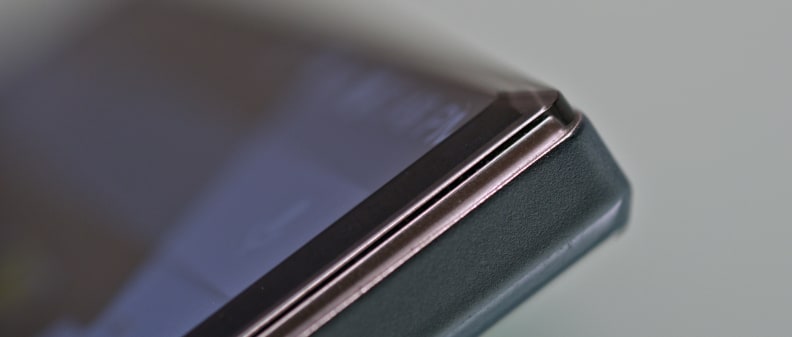
Chamfered plastic redirects your skin away from the screen.
I'm still not sold on the user-facing camera living on the bottom bezel, but I suppose it had to go somewhere. It's not like there really was anywhere else it could go, to be honest—but the phone doesn't really suffer many drawbacks as a result of its design. Really, the only major sticking point people might have is that the phone's plastic back is a bit thick; though it's very easy to cradle in your hand.
Hardware
Like the bezel, super svelte
Though outward appearances are the most striking part of the phone, it's worth hashing out just exactly what you're getting with the Aquos Crystal. To put it rather bluntly: you're getting something that looks good, not something that's built for the long haul.
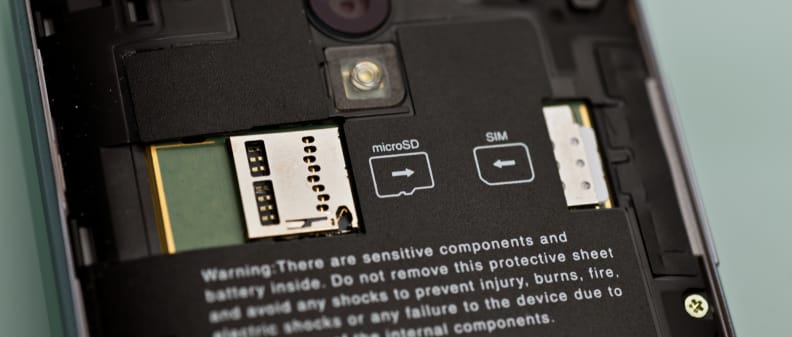
Don't worry about limited memory—you can always stuff in a microSD card if you pop off the back.
On the plus side, under the hood the Crystal is fairly similar to the Moto G—it has the same Qualcomm Snapdragon 400 processor, the same 8 gigabyte base memory configuration, and slightly more RAM (1.5 gigabytes). However, a good phone isn't merely the sum of its parts, and this is where the phone's software lets it down a bit. Though the Crystal runs a mostly-stock version of Android 4.4.2, it's loaded with carrier crapware. We often rail against this because it doesn't do much other than gum up the works and annoy users. The same is true here, though the addition of WiFi calling is a huge check in the plus column.
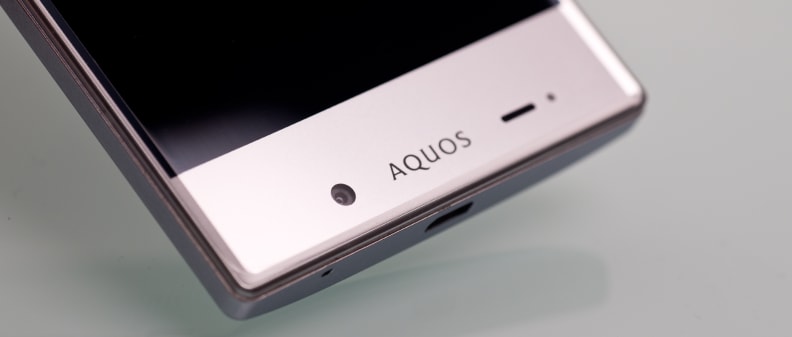
Without a bezel, the camera and ambient sensors live at the bottom of the obverse.
You'll find no fault with the 5 inch, 720p LCD on the front of the phone, and the bezel-less design is a lot more useful than you might think. A user-facing camera and light sensors are on the bottom of the obverse, and physical buttons are tastefully restrained. Like most other phones, this unit charges over a microUSB port, and has a headphone jack for music junkies.
To be honest, this phone is just about as basic as you can get while still offering essential daily-use features like navigation and Google Now. While it doesn't offer fancier features like NFC, standalone GPS, or the latest version of Android, the Aquos Crystal has enough to satisfy the casual user. For those of you on extremely basic plans, the aforementioned addition of WiFi calling is a great way to dodge burning through your minutes.
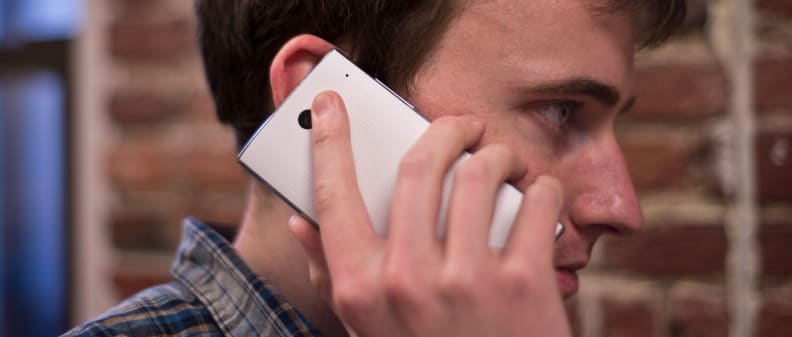
Despite a 5-inch screen, a phablet this is not.
I will point out that the phone only works on Sprint (and Sprint-using MVNOs), despite its carrier unlocked status. On the plus side, that means you can use services that uses the cellular bands offered by Sprint; So MVNOs like Boost Mobile are also on the table for you if you pick up this phone. Definitely check to see if Sprint offers service in your area, as it can be somewhat spotty outside of major metropolitan areas. Though it's not really fair to fault a phone for the failings of a service provider, it can be enormously frustrating to have a wonderful piece of hardware that won't work because the coverage is missing (or bad in your area).
Camera
This isn't a replacement for any camera you own
Given the smartphone's super low price, you start to wonder where corners were cut. And while you may or may not notice an older processor if you don't stress the device, you will absolutely notice the subpar camera if you're a social shutterbug. While an 8 megapixel camera is par for the course nowadays, this one just doesn't seem to want to work all that well.
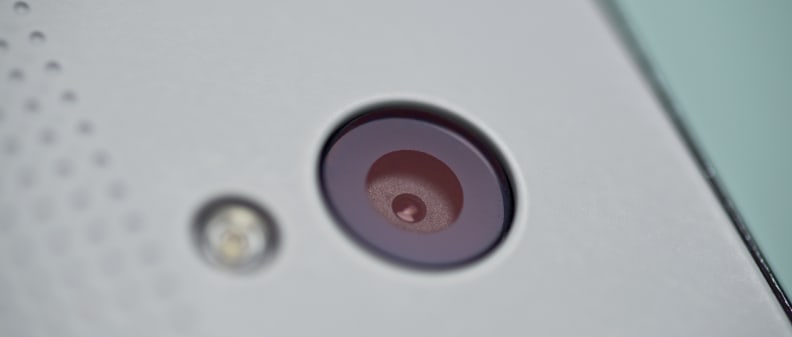
Sharp, your camera: Woof.
It's not surprising, and in fact most of the other budget smartphones we tested in the past have the same exact problems. It's a bit of a letdown, given that the whole experience of taking photos is just so darn rewarding with that bezel-less screen, and full-featured camera app. It reminds us a lot of the ZTE Nubia 5S Mini LTE: its additions of things like a golden rule overlay, ISO controls, and sequential shooting allow you to take a more active role in crafting your shots, even if the end result isn't exactly magazine-worthy.
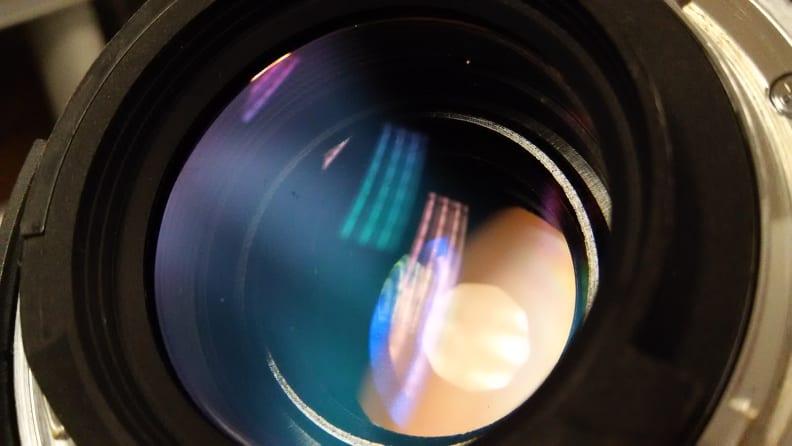
Color is tastefully oversaturated, but that's where the good news ends.
Color is relatively decent; you can expect a passable white balance correction under 1000 kelvin in most lighting conditions, though color performance at best hits a not-so-great ∆C 00 saturation error of 3.05 with an overall saturation of 119.3%. We find many super-cheap point and shoot cameras hover somewhere around here, though in recent years that category has improved.
Sharpness is where things start to get really wonky. Though we typically look for a cellphone camera to resolve at least 1400 line-widths per pair to look decent, in ideal conditions the Crystal's camera can only resolve 1118.5 with a tiny bit (8.49%) of oversharpening. But that's only in ideal conditions—noise reduction will rip away fine details in lower light.
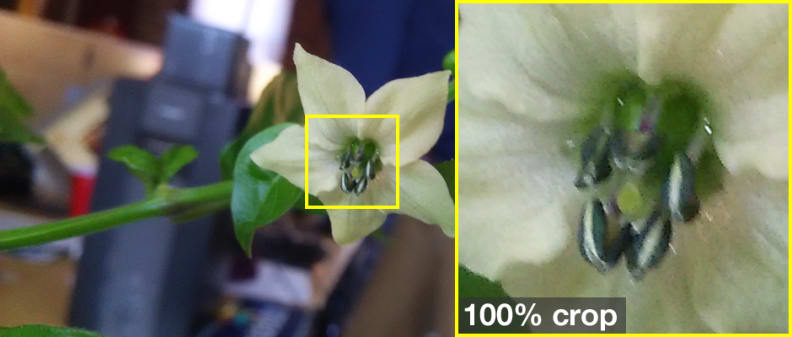
At 100%, photos are grainy and soft.
Though noise levels aren't high, that's largely due to the fact that the camera's noise reduction algorithm is unbelievably aggressive. So aggressive, that fine details are eliminated with extreme prejudice in photos. Even in lighting conditions that aren't so adverse, you can expect a certain level of detail loss that ranges from the disappointing to wretched.
Video, too, suffers from all these setbacks. While it's unfair to expect high-quality cinema from your phone, the Sharp Aquos Crystal really doesn't do itself any favors here. Heavy artifacting combined with detail loss makes for a strange video file. It's fine enough for sharing online, but you'll definitely notice the low quality even in a reduced resolution.
Performance
Like the bezel, extremely bare-bones
Knowing ahead of time that the hardware is a little anemic, it's no surprise to us that the Sharp Aquos Crystal isn't built for setting any benchmark records. Channelling my inner Dr. McCoy for a moment: It's a budget unlocked phone—not a flagship. You can't expect it to be the best thing since sliced bread.
In any case, it's easy to forgive the poor processor benchmarks when your general operation of the device really isn't hampered much. Sure, it chokes on video and games, but then again, so do the other budget phone options out there. Honestly, the situation isn't as bad as I expected—HTML5 video seems to run fine, and while framerates on graphic content can plummet to 15fps, there are worse problems to have. The Crystal is no Moto E, but it definitely doesn't do much to impress anybody.
The panel on the Crystal underperforms when compared to other budget phones, but the shortfall of this screen compared to other budget LCDs really isn't all that huge. While you probably won't notice pixellated images on a 5-inch, 720p LCD (288 PPI), images won't exactly look as sharp as they could on something like an LG G3. The Crystal's contrast ratio is narrow at full brightness (832:1), owing in large part to its high black level of 0.48 cd/m2 . A peak brightness of 399.37 cd/m2 means that you'll be able to see the phone's image even in bright sunlight, though the reflectivity is a little on the high side at 5.7% direct reflectivity, 13.68% total.
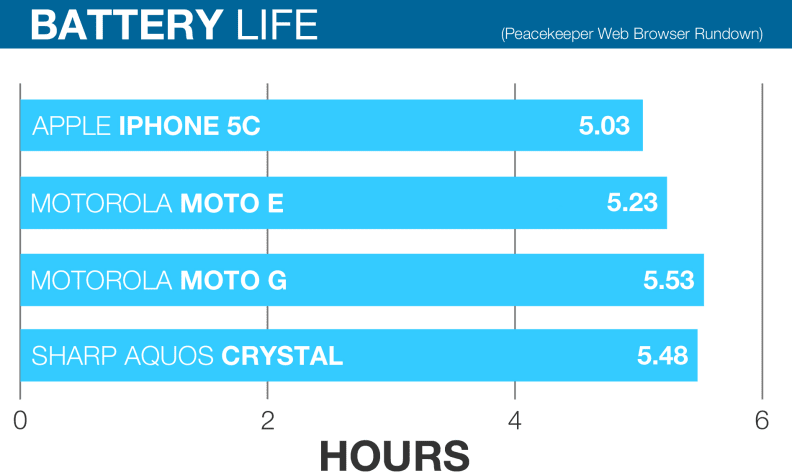
Battery life is the best thing about the Sharp Aquos Crystal's performance by a longshot.
One of the best things to accompany many of the budget phones with near-stock Android is the battery life. Though the 2,040mAh battery isn't the biggest cell we've seen in a handset, it powers the phone through some really punishing tasks. In our labs, it was able to withstand a hair over 5 hours in our web browser rundown test—no small feat when you consider that the newest iPhones couldn't even crack 4 hours in the same test. If you elect to buy the Sharp Aquos Crystal, you'll be carrying a handset that just doesn't quit on you.
Conclusion
Value phone with stunning design
At the end of the day, bargain hunters will be happy with the Sharp Aquos Crystal. Though this mobile definitely doesn't do much to set any performance records, it provides the basics without really becoming much of a liability in other areas. While that probably doesn't sound exciting, it's high praise for a device if all you're looking for is something to be your sidekick without too much fuss or fanfare. It's a $150 unsubsidized phone. It's basically impossible to ask for more for the money.
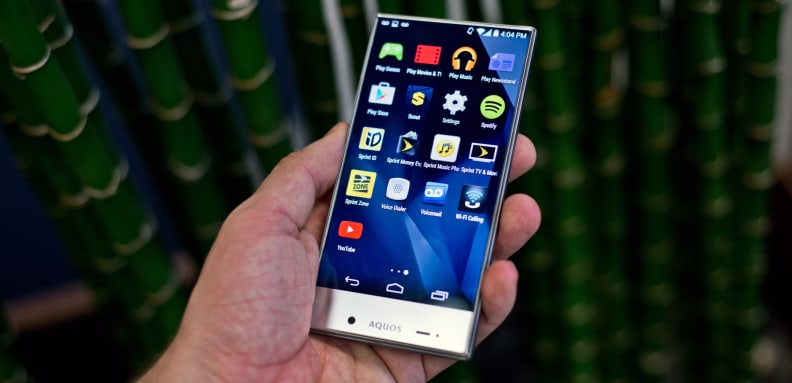
It takes a while to get used to the lack of a bezel.
To its credit, the Aquos Crystal is amazingly well-designed for a device so inexpensive. And even though it's not a flagship phone, it definitely looks the part—from the front anyway. The Sharp Aquos Crystal is easily the coolest-looking phone I've held in recent memory. Ditching the bezels is a stunning design feature, and the chutzpah to pull a move like that on a budget phone is deserving of nothing but praise.
However, with a low price that praise comes with caveats. It's definitely a great value, but this phone is certainly not the mobile you're going to want for the next few years. It's the quintessential budget phone outside of the design. Simply put: If you want great pictures, solid processor performance, or top-of-the-line screen performance, you're looking at the wrong handset. The Aquos Crystal absolutely checks all the right boxes for a value shopper, but despite its high-end appearance it'll only last the required two years most expect if and only if your mobile is primarily used as a phone.
It's tough to find competitors that meet the Crystal on price, but we stick by the Moto G with LTE as another solid bargain phone if you're willing to spend around $50 more. It's a lot like the Aquos Crystal under the hood—but instead of being limited to Sprint's CDMA network, it can be used with AT&T, TMobile, or Verizon—including a huge list of MVNOs.
Meet the tester
A seasoned writer and professional photographer, Chris reviews cameras, headphones, smartphones, laptops, and lenses. Educated in Political Science and Linguistics, Chris can often be found building a robot army, snowboarding, or getting ink.
Checking our work.
Our team is here for one purpose: to help you buy the best stuff and love what you own. Our writers, editors, and lab technicians obsess over the products we cover to make sure you're confident and satisfied. Have a different opinion about something we recommend? Email us and we'll compare notes.
Shoot us an email
